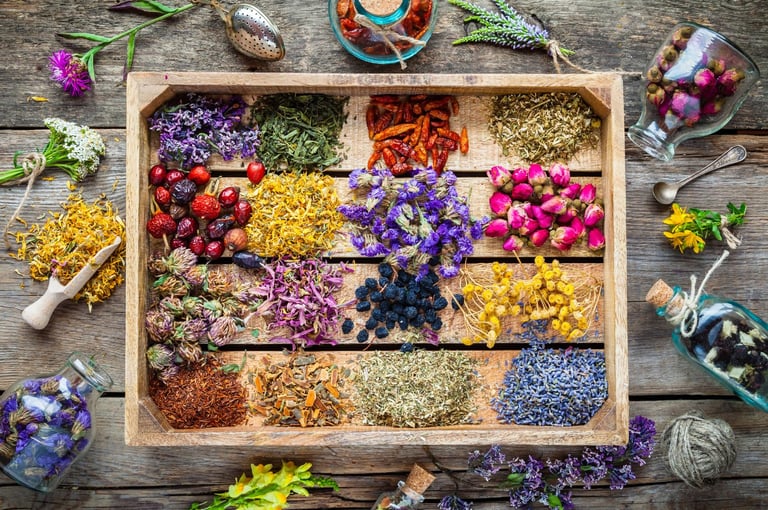Research-based Tips and Strategies to Naturally Improve PMDD
FEMALE HEALTH
Written by Keith - Nutritionist, Herbalist, and Researcher
8 min read


Premenstrual Dysphoric Disorder (PMDD) is a severe form of PMS that impacts the lives of millions of women around the world. The number of people with PMDD may be increasing due to several factors. The intake of inflammatory vegetable oils, insulin-spiking carbohydrates, too much caffeine, high stress, long-term smoking, and other factors may contribute to PMDD. 1 Poor dietary and lifestyle habits can profoundly impact hormones and neurotransmitter balance. Research has shown that there may be a neurochemical component to this condition. Women who suffer from PMS and PMDD tend to have low levels of serotonin, GABA, and beta-endorphins.
Past traumas and genetic influences may also play a role in the development of Premenstrual Dysphoric Disorder. Recent evidence points to several genetic pathways that influence estrogen and serotonin as a component of PMDD. 1 However, it's important to realize that these things don't defy how you have to function if you're currently afflicted with this. Things can improve with the right steps and positive action. PMDD is usually characterized by intense physical and emotional symptoms that occur in the week or two before menstruation. While some may feel better once menstruation begins, others may still experience severe pains.
Some of the emotional and mental symptoms may include:
Irritability, anxiety, less self control, difficulty sleeping or concentrating, fatigue, depression, low self-image, crying spells, worsened memory, feeling on edge, heightened emotional sensitivity, and more.
Some of the physical symptoms of PMDD may include
Swelling and fluid retention, headaches, dizziness, lightheaded, breast tenderness or swelling, bloating, changes in appetite, tingling sensations, joint pains, hot flashes, muscle spasms, heart palpitations, gastrointestinal symptoms, and more.
While PMDD can profoundly impact one's quality of life, several strategies may help decrease the severity of symptoms and improve overall well-being. In this article, we will explore some of the best strategies to improve PMDD.
1. Dietary Changes
Being conscientious about your diet can go a long way for just about any condition. The inflammatory nature of products such as heated, unstable vegetable oils, high glycemic sugars, highly processed foods, fried foods, trans fats, snacks, sodas, and others can take a larger toll on mental and physical health than it seems. This is because a diet that is high in these types of foods can cause fluctuations in hormones and neurotransmitters, as well as ignite chronic inflammation.
Adopting a diet rich in nutrients that promotes healing is one of the best things you can do for long-term wellness. Foods such as wild-caught salmon, pomegranate, organic sprouted walnuts and pumpkin seeds, sardines, bilberries (helps promote circulation), kiwis (helps protect DNA), purple or red rice, herring, watercress, and others will positively influence hormones and overall balance of the body over time. For some, a low-histamine diet may also be helpful for PMS, PMDD, and severe menstrual cramps.
2. Nutritional & Herbal Supplements
References:
1. https://www.ncbi.nlm.nih.gov/books/NBK532307/
2. https://www.ncbi.nlm.nih.gov/pmc/articles/PMC6422848/
3. https://pubmed.ncbi.nlm.nih.gov/9731851/
4. https://www.ncbi.nlm.nih.gov/pmc/articles/PMC5153575/
5. https://examine.com/research-feed/study/summary-dV4VJ0/
6. https://www.ncbi.nlm.nih.gov/pmc/articles/PMC3208934/
7. https://www.ncbi.nlm.nih.gov/pmc/articles/PMC7792881/
8. https://www.ncbi.nlm.nih.gov/pmc/articles/PMC9228580/
9. https://www.sciencedirect.com/topics/neuroscience/rhodiola-rosea
10. https://www.frontiersin.org/articles/10.3389/fphar.2018.01415/full
11. https://www.sciencedirect.com/science/article/abs/pii/S0378512206002398
12. https://pubmed.ncbi.nlm.nih.gov/20155996/


Nutritional supplements may be one of the safest and most effective ways to improve PMDD without risky side effects. However, finding the right combination can take time and patience, as symptoms are very specific to each person. The good news is that many nutrients and herbs show excellent potential and may help to improve your overall well-being within a fairly short amount of time. If one thing doesn't work, keep at it until you've exhausted all options. Persistence always pays off when it comes to healing any condition. In this section, we will list some of the top nutrients that have actual research behind them for symptoms of PMS and PMDD.
Calcium, Zinc, and Vitamin D3
Calcium and vitamin D3 play a crucial role in maintaining mood and hormonal balance. Evidence suggests that women with PMS and PMDD may have lower levels of calcium and vitamin D3 during the luteal phase of their cycle. 2 These low levels can heighten mood swings, irritability, fluid retention, blood pressure, and more. One study showed that calcium supplementation caused a surprising improvement in several symptoms of PMS / PMDD, although it likely won't be enough to overcome this condition alone. Zinc may be another helpful mineral for PMS, PMDD, and menstrual pain. Studies show that levels may be low in women with severe symptoms.
Zinc plays a critical role in female reproductive health by helping to maintain healthy ovarian and follicle cells. It is needed for DNA and protein synthesis and is important for healing damaged tissue. Another mechanism in which zinc is helpful is as a cofactor in serotonin production. However, with zinc, it's very important to be careful when supplementing. Many supplements can cause abdominal pain because they supply too much per serving. The body prefers a small amount of zinc per serving, so make sure to keep doses at around 8-12 mg per serving and take several days off per week. 3, 4, 5
Magnesium
Magnesium is involved in hundreds of biochemical processes in the body and is in high demand at all times. It is a fantastic compound that has calming effects on the nervous system and muscles. Magnesium is a catalyst that helps the body and nervous system work better. Several studies have shown that magnesium supplementation is critical for improving PMS and PMDD. In one placebo-controlled study, women were separated into three groups. One took magnesium, one placebo, and one magnesium + B6. The group taking magnesium with B6 saw the greatest improvement in symptoms. 6 There is synergy between magnesium and the correct form of B6, which is why we include both in Calm Cycle.
Saffron
Saffron is a fantastic and underrated compound for brain and mood health. It affects several neurotransmitters in the brain and may be very helpful for PMDD. According to one study with 120 women, saffron showed vastly superior benefits when compared to placebo. 7 The evaluation was based on a daily record of the severity of problems for both groups, with saffron improving different symptoms of PMDD over 2 months. Make sure when looking for saffron that it is authentic, with good, testing, as saffron is one of the most knocked-off spices in the world.
Rhodiola
Rhodiola is a powerful plant that is often used for fatigue, anxiety, depression, cardiovascular health, brain health, stress, physical performance, and more. 8,9,10 It has some evidence for several of these conditions, although more evidence is needed to solidify it for many of these conditions. However, rhodiola shows excellent potential and safety according to many studies. For PMDD, some people have noticed good benefits while supplementing with it, although not all. It can depend on many factors whether a supplement is the right fit for your specific body and brain. Rhodiola usually comes in the form of rhodiola rosea, although the rhodiola crenulata form is sometimes preferred for its more energizing effects. When using rhodiola, it's best to start with a conservative dose to gauge the effects before taking more.
Chasteberry
Chasteberry, also known as Vitex agnus-castus, is a popular herbal remedy for PMDD. It helps regulate hormone levels and has been shown to reduce breast tenderness, mood swings, and irritability associated with PMDD. In one study with 109 women, chasteberry extract showed significant benefits for symptoms of PMS & PMDD. According to the data, symptom severity was reduced by about half after the third month of supplementing with vitex. 11 Vitex helps to raise progesterone, which can sometimes be low in those with PMS and PMDD. Pairing chasteberry with magnesium and B6 (P5P form) would be a good way to raise progesterone if your levels are low. It is available in supplement form and should be taken as directed by a healthcare professional.
St. John's Wort
St. John's wort is a well-known herbal supplement that is most often used for nerve pain and mood. It may help reduce symptoms of depression and sadness associated with PMDD, although more research is needed on this. St. John's Wort appears to interact with the serotonergic system, which can influence mood. One clinical study validated the effects of St. John's Wort for PMS by comparing it to placebo. The study did show benefits when compared to placebo, although the effects on PMS-related mood and pain weren't very pronounced. 12 There may be another mechanism that wasn't evaluated in detail that causes the benefits. However, St. John's may interact with certain medications, so make sure to clear it with your Healthcare practitioner before using.
3. Exercise
Engaging in regular physical activity has been shown to reduce the severity of PMS symptoms, which will certainly impact PMDD as well. Studies show positive results for not only PMS but overall mental and emotional health. One placebo-controlled study sought to understand the impact of exercise on different symptoms of PMS. After 8 weeks of consistent training, the group engaging in exercise experienced positive changes mentally, emotionally, and physically when compared to placebo. 13 Exercise releases endorphins, stimulates circulation and lymphatic drainage, and improves brain chemistry. Aim for at least 20-30 minutes of moderate-intensity exercise such as brisk walking, swimming, cycling, or specific movements 4-5 days per week.
4. Stress Management
While it may be a bit trite to talk about stress in 2024, it is still to place importance on always improving our management of it in this modern world. We know that stress affects us in numerous ways mentally, emotionally, and physically. It worsens just about every aspect of health, PMDD included. While it is certainly a challenge to stay away from all stressors in life, it's good to incorporate stress management techniques into your daily routine. A walk in nature with deep breathing can be very healing and uplifting. Learning how to relax the nervous system throughout the day will be extremely valuable to PMS, PMDD, and overall quality of life.
4. Cognitive-behavioral therapy (CBT)
Cognitive-behavioral therapy (CBT) is a type of talk therapy some people find to be beneficial for managing PMDD symptoms. It focuses on identifying and changing certain thought patterns and behaviors that contribute to distress. CBT can help individuals develop healthier coping strategies and improve overall emotional well-being. One randomized trial that recruited 174 with PMDD put cognitive-behavioral therapy to the test. Subjects underwent 8 weeks of internet-based cognitive therapy. Upon analysis after the study ended, those in the treatment group saw an improvement in their levels of stress, the overall burdensome feeling, and their ability to cope better with the condition. Although it is certainly not a cure, CBT appears to be a useful tool that may benefit many women with PMDD. 14
5. Supportive Relationships
Building a strong support network can significantly impact how one copes with PMDD. Surround yourself with understanding and supportive friends and family members who can provide emotional support during difficult times. Consider joining support groups or seeking therapy to connect with others who are experiencing similar challenges.
While PMDD can be challenging to manage, these and other strategies can help alleviate symptoms and improve overall well-being. Adopting a healthy lifestyle, exploring herbal and dietary supplements, checking out cognitive-behavioral therapy, and prioritizing good relationships can all contribute to a better quality of life for individuals with PMDD. Remember to consult with a healthcare professional if you're on any medication and want to start any new treatments or supplements to ensure they are appropriate for your specific situation.

